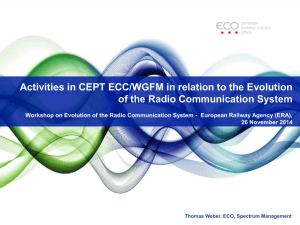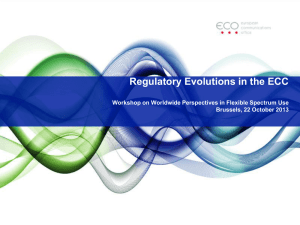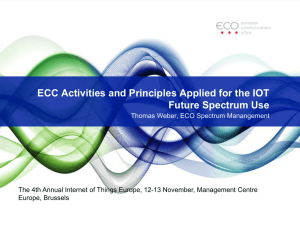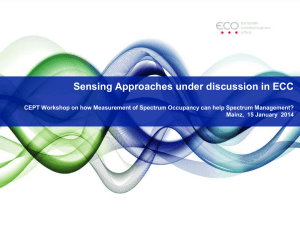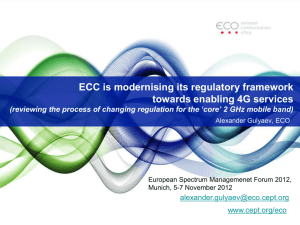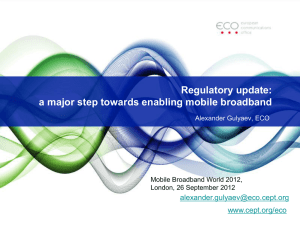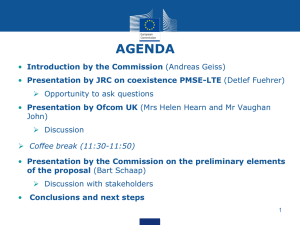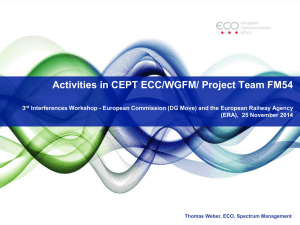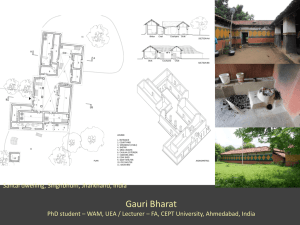ECC update: some highlights of ECC`s recent regulatory
advertisement
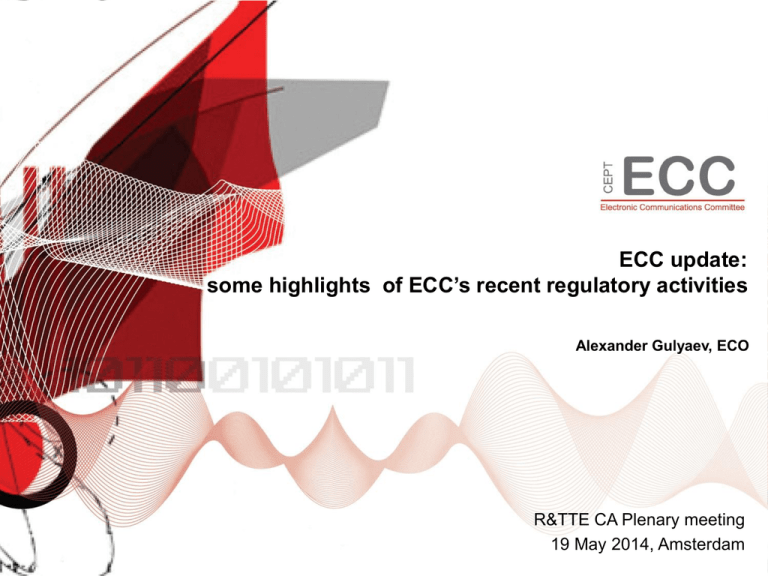
ECC update:
some highlights of ECC’s recent regulatory activities
Alexander Gulyaev, ECO
R&TTE CA Plenary meeting
19 May 2014, Amsterdam
Outline
Outline:
1. 5GHz Wi-Fi “extension bands”: a complex technical
task
2. 3400-3800 MHz range: updated technical conditions
for base stations and terminals
3. PMSE: securing the future from a spectrum
perspective
Footer - add copy here
1
Current trends in developing new ECC regulatory frameworks
Recent years ECC regualtory policy aims to ensure the
continued liberalisation of existing regulatory provisions
(especially where technology neutrality is promoted), the
exemption of devices from individual licensing, and how new
services may be introduced on a shared-spectrum basis with
existing ones
Notified Bodies are encouraged to follow ECC Newsletters
which address most important activities within the ECC and
may have impact on the work of Notified Bodies (most recent
ECC Newsletter is of April 2014 (this presentation is based on
the content in this Newsletter but tailored to the R&TTE CA
context)
Footer - add copy here
2
5GH Wi-Fi “extension bands”: a complex technical task
•
The greater growth is now in data traffic over RLAN networks
(Wi-Fi) than over mobiles, although Wi-Fi access points are
considered as complementary to mobile internet services.
Nomadic and static Wi-Fi usage profiles stipulate the need for
higher spectrum bandwidth!
•
Majority of Wi-Fi devices in use today are still operated in the 2.4
GHz band (83.5 MHz wide) and are using 20 MHz or 40 MHz
channels. A new generation of Wi-Fi (known as IEEE 802.11ac)
will be able to achieve throughput rates sufficient enough to
extend existing high-speed fixed broadband infrastructures
wirelessly (providing data rates of 30 or 100 Mbps or more when
using 80 MHz and/or 160 MHz channels)
Footer - add copy here
3
5GH Wi-Fi “extension bands”: a complex technical task
•
EU: Digital Agenda for Europe: sufficient spectrum resources should be
available on a harmonized basis to support the evolution (in particular,
the use of larger channel bandwidths) of WAS/RLAN technologies
•
EC Mandate to CEPT (September 2013) to develop harmonized
technical conditions for WAS/RLAN in the bands 5350-5470 MHz and
5725-5925 MHz ('WAS/RLAN extension bands'). The aim: to enable a
future Wi-Fi usage of the whole range 5150-5925 MHz (including the
455 MHz of already designated in 5 GHz spectrum) based on a general
authorisation
•
The new WAS/RLAN spectrum bands are also under discussion in the
preparation for AI 1.1 of WRC-15 (primary allocation to Mobile Service).
Footer - add copy here
4
5GH Wi-Fi “extension bands”: a complex technical task
•
Technical challenge in the 5 GHz: many incumbent users in the band
(as well as in the adjacent bands) also have high priority and right to
protection, including:
o the European Earth monitoring programme GMES (Global
Monitoring for Environment and Security), now known as
“Copernicus”, and
o ITS (Intelligent Transport Systems), including safety-related systems
•
The interference situation in the current “5 GHz Wi-Fi bands” (i.e. 51505350 MHz and 5470-5725 MHz) should continue to be in the focus of
NBs (recent ECC Report 192 on issues with Dynamic Frequency
Selection in the 5 GHz range, Final Report on ADCO R&TTE 5 GHz
campaign, coordination of follow-up actions at the European level)
Footer - add copy here
5
5GH Wi-Fi “extension bands”: a complex technical task
Timing: the CEPT work in response to the EC Mandate is divided
into three steps:
•
Interim Report (March 2014) - a description of work undertaken
and interim results under tasks (1) and (2) of the EC Mandate
•
CEPT Report A (March 2015) – main technical results before
WRC-15, and
•
CEPT Report B (July 2016) – ‘sanity check’ after WRC-15 (in
order to reconfirm the technical conditions provided in CEPT
Report A)
Footer - add copy here
6
5GH Wi-Fi “extension bands”: a complex technical task
Notified Bodies:
•
follow closely the evolution of the ETSI standards and national
regulatory frameworks of European countries in respect of the
DFS requirements in Wi-Fi consumer products in the existing 5
GHz bands (5150-5350 MHz and 5470-5725 MHz), based on the
conclusions of ECC Report 192
•
follow and note the outcome of the CEPT work on the technical
requirements for the “WAS/RLAN extension bands” (5350-5470
MHz and 5725-5925 MHz)
Footer - add copy here
7
3400-3800 MHz range: updated technical conditions for
base stations and terminals
•
The 3400-3800 MHz is a large amount of still partly under-used
spectrum open for future, truly broadband, mobile applications
•
ECC used over two years for studies to complete its regulatory
and technical work for this band since the adoption in December
2011 of a Decision (ECC/DEC/(11)06)
This work has resulted in:
•
ECC Report 203,
•
CEPT Report 49, and
•
updated ECC/DEC/(11)06
Footer - add copy here
8
3400-3800 MHz range: updated technical conditions for
base stations and terminals
Scope of review of ECC/DEC/(11)06:
•
TDD was declared as the "preferred" frequency arrangement and
FDD – as an "alternative" for the 3400-3600 MHz sub-band (the
upper sub-band 3600-3800 MHz was initially harmonized for
exclusive TDD use)
•
Block Edge Masks (BEMs) for TDD and FDD modes were
developed which are applicable to MFCN base stations with
different power levels (i.e. macro, micro, pico and femto BS).
Footer - add copy here
9
3400-3800 MHz range: updated technical conditions for
base stations and terminals
•
The updated ECC/DEC/(11)06 does NOT contain a BEM for
terminals (UE – user equipment), therefore terminals out-of-band
emission (OOBE) levels will be specified only in the relevant
ETSI standards.
HOWEVER:
EC ECC/DEC/(11)06
Decision 2014/276/EU
the current
• A
Thenew
updated
contains(amending
a recommended
value of EC
Decision
the 3400-3800
is binding
maximum2008/411/EC
UE in-blockonpower
which is MHz)
set towhich
25 dBm
(it’s on
EU
Member
specifies
the maximum
powerand
value
specified
as States
e.i.r.p. for
UEs designed
to be UE
fixedin-block
or installed
of
dBm
“technical
conditions
for terminal
stations” but contains
as 25
TRP
foras
UEs
designed
to be mobile
or nomadic).
a provision stating that Member States may relax this limit under
• certain
A tolerance
of up to 2 dB
been included
in thestation.
above limit, to
circumstances,
forhas
example
fixed terminal
reflect operation under extreme environmental conditions and
production spread.
Footer - add copy here
10
3400-3800 MHz range: updated technical conditions for
base stations and terminals
Notified Bodies:
•
in assessing the compliance of 3400-3800 MHz IMT terminals
attention should be paid to the actual relevant national
regulation, i.e. the arbitrary chosen maximum in-block power limit
which is set in ECC/DEC/(11)06 and EC Decision 2014/276/EU
to 25 dBm as a default value.
Footer - add copy here
11
PMSE: securing the future from a spectrum perspective
•
TV, theater and other show progamme making facilities have a
huge public and social importance; look at the public interest to
the recent Eurovision contest 2014 in Copenhagen!
•
The need for frequencies (for audio, video and service links) that
support the making of programmes, as well as a much wider
range of cultural, social and economic activity, are a major
element in the frequency management. However, wireless
microphones are in international frequency law the 'secondary
service‘!
•
CEPT has carried out an extensive series of studies, also in
response to the recent EC Mandate which will serve as a
technical basis for the Commission's next steps in policy-making
towards PMSE (Programme Making and Special Events).
Footer - add copy here
12
PMSE: securing the future from a spectrum perspective
Three elements of the recent CEPT work related to PMSE:
•
Duplex gaps at mobile allocations in 1800 MHz and 800 MHz,
and also in the 700 MHz (duplex band and guard band)
•
“L-band”:
o 1452-1492 MHz range was considered as a potential new space for
PMSE, however this is now harmonized by ECC/DEC/(13)03 to
mobile supplemental downlink (SDL).
o 1492-1518 MHz band has recently been identified by CEPT for
indoor operation of wireless microphones
o 1518-1525 MHz band is currently under study
•
Cognitive approaches: more as a means of protecting PMSE
from 'white space devices' than as a vehicle for PMSE itself
Footer - add copy here
13
PMSE: securing the future from a spectrum perspective
Major CEPT/ECC deliverables on PMSE:
•
ECC Decision (09)03 on MFCN in the 800 MHz band (Annex 3,
section 3.1 – “Technical conditions for PMSE equipment”)
•
ERC Recommendation 25-10 (currently under review): the tuning
ranges for PMSE
•
ERC Recommendation 70-03 (Annex 10)
•
ECC Report 191 and an addendum to CEPT Report 50 (usability
of center gaps in the 1800 MHz and the 800 MHz mobile
allocations):
•
CEPT Report 51: 8 frequency bands between 2 and 8 GHz which
were proposed as alternative bands for cordless cameras
•
ECC Report 204: spectrum use and future requirements for PMSE
Footer - add copy here
14
PMSE: securing the future from a spectrum perspective
Need to explore further sharing opportunities to accommodate
PMSE spectrum requirements, e.g. in the L-band: the spatial
environment of downlink frequencies is much more predictable
(given a channelling plan and specific base station siting) than for
uplinks with their mobile terminals eventually being placed
anywhere…
Footer - add copy here
15
PMSE: securing the future from a spectrum perspective
New technologies for wireless microphones:
•
short and medium term: wireless microphones will remain largely
analogue devices, while digital solutions could provide for
greater security of quality in environments of light to moderate
interference
•
cognitive techniques for individual microphones is rather a longterm option
Footer - add copy here
16
PMSE: securing the future from a spectrum perspective
Notified Bodies:
•
in assessing the PMSE equipment attention should be paid to
multiple PMSE frequency options, varying from country to
country, and the associated technical conditions in CEPT
regulations and relevant ETSI harmonsied standards.
•
More complex technical requirements ensuring compatibility of
PMSE with other ‘primary systems’ may be expected in the future
that will in turn result in higher complexity of test reports and
more sophisticated assessment procedures.
Footer - add copy here
17
ECC deliverables currently under the public consultation
ECC deliverables open for public consultation are available at:
http://www.cept.org/ecc/tools-and-services/ecc-public-consultation
18
ECO is always ready either to respond directly to the requests from
R&TTE CA regarding ECC regulations or to assist in consultations
between R&TTE CA and relevant ECC specialist groups
alexander.gulyaev@eco.cept.org
www.cept.org/eco
www.cept.org/ecc
